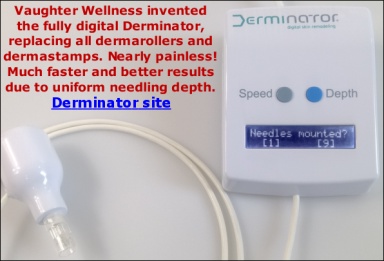If your skin is sun-damaged, you can try Tretinoin (Retinoic acid) cream (we sell it). Initially, it makes skin dry and the dryness makes wrinkling temporarily more visible but the skin gets used to Tretinoin and long term, it improves the appearance of wrinkling.
There are even studies claiming that Retinol (Retinol is metabolized to Retinoic acid in the skin) improved cellulite but I am not sure how effective this is in reality.
No, do not use needles longer than 2 mm. Skin is not any thicker than that, except for certain special areas such as foot soles A 2 mm dermaroller penetrates about 1.8 mm to the skin.
Topical retinol improves cellulite
1999, Vol. 10, No. 2 , Pages 119-125
Am Kligman, A Pagnoni and T Stoudemayer
University of Pennsylvania, School of Medicine, Department of Dermatology, Philadelphia, PA, 19104, USA
A group of 20 women with moderate cellulite of the thighs were treated twice daily on one side for 6 months with a 0.3% stabilized retinol cream while the opposite side was treated with the vehicle, following a double-blind format. Objective measurements included ultrasound measurement of thickness using a 20 MHz B-scan, and laser Doppler velocimetry for blood flow. The panelists and a dermatologist estimated the degree of improvement on a global scale. Of 19 subjects, 13 rated the retinol side as more improved, 7 registering good effects. The dermatologist's estimates were largely congruent with those of the subjects. There was also a marked reduction in the density of hypoechogenic areas on the retinol sides, from 53% to 18% of black pixels on image analysis. Blood flow measurements were unchanged on the vehicle sides but increased significantly on the retinol sides. Thickness measurements by ultrasound scan were unchanged on the vehicle sides but increased significantly on the retinol sides, from 1.44 to 1.60 mm. Retinol may be viewed as a prodrug which the skin metabolizes to retinoic acid. The beneficial effects of retinol are consistent with previous reports of increased synthesis of glycosaminoglycans and collagen.






